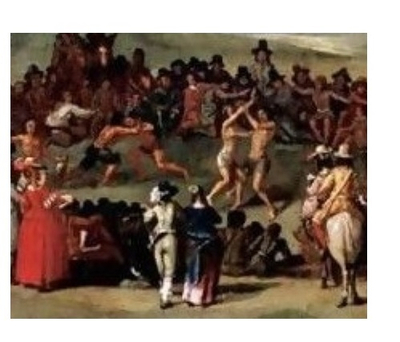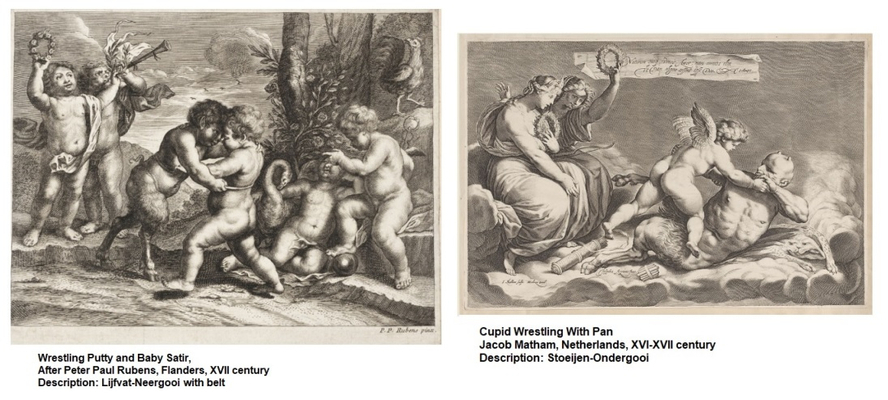
Boers Wrestling Styles (South Africa)
- Name of sport (game): Boers Folk Wrestling Styles (South Africa)
- Place of practice (continent, state, nation):
South Africa
- History:
The Boers or Afrikaners are South African people of Dutch, Flemish, German and French (Huguenot) descent.
Usually the Boers folk wrestling matches along with other rustic sports (the Boeresport) like climbing the slippery pole, foot racing, sack race, leaping, three-legged race, running with an egg in the spoon, tug of war, arm wrestling, archery, spit sheep manure, stick fighting and etc. were played on the annually held festival called the Farmers’ Day (the Boeredag). The games/festival would start with an opening prayer and reading of the Scriptures. It was a day of joy and the main festive gathering of the Afrikaner people of the area.
The 1902 newspaper article thus spoke of the Boers wrestling: “Amongst the young Boers wrestling is exceedingly popular. The champion wrestler of a district is as much thought of as is his confrere in the North of England. Such a man can always have the pick of the prettiest girls in the district for a wife.”
In his memoirs Boer military commander General Ben Bouwer (1875-1938) mentioned the popularity of wrestling pastime among the Boer officers. He gives an account of his success in a wrestling match against a local strongman and wrestling champion General Manie Maritz (1876-1940). A horse was at stake in that contest. The famous South African pro wrestling champion Manie Maritz (1925-2018) was the son of that military of the same name.
Wrestling customs of the Boers were of Dutch/Flemish origin. By the beginning of the XX century traditional folk wrestling styles were long forgotten in the Netherlands and Flanders, but they were still actively practiced by the Boers in the XVIII and XIX centuries. It appears that historically an organized pro wrestling wasn’t as common in the Netherlands and Flanders as let’s say it was in England.
Different kinds of wrestling games which were popular among the local farmers (boers), along with cudgels, were played during various folk and religious festivals such as Kermis van Sint Joris/Kermis of St. George (Patron of Military and Martial Arts).

- Description:
The wrestling styles (worstelen, wrestling or werpen/gooien throwing) of Dutch and Flemish people existed in two distinctive modes, the standing wrestling for a throw (neergooien, smijten, smakken throwing someone down, giving a fall; or ondergooien throwing someone down on his back, giving a back fall) and the up and down wrestling for taking someone down and overcoming him on the ground/keeping him underneath, also Dutch Onderwerpen to subject, to submit, to bring/put under, same as German Unterwerfen to subdue, to submit or Unterwerfung submission, pinning fall).Those two modes corresponded to the “Half” (Halber) and “Full” (Ganzer) modes of German folk wrestling the Ringen respectively.
Among the wrestling techniques used by the Dutch/Flemish farmers were aanklampen (catching holds) and vasthaken (hooking legs). Both of those wrestling skills are shown on a XVII century painting by unknown Flemish artist called “An elegant crowd watching men wrestling in a landscape.” On this painting the wrestlers are shown barefoot and their only attire is either a drawers or a loincloth. Notably, the portrayed on this painting catch-hold of one of the two pairs of wrestlers is a typical pro wrestling opening hold when wrestlers grab by the back of the necks and elbows. Plukharen (grasping hair) as well as any other non-wrestling or deliberately brutal acts were strictly prohibited during the wrestling contests.
Before the match the two boers negotiated the wrestling conditions of the match, whether it’ll be Lyfvat Neergooien/Ondergooien or Stoeijen.
Lyfvat (Lijfvat, Lijfvatten) was an equal above and under grip around the torso/waist (German Bauern-Griff, Peasants Grip). Originally it was a fixed hold archaic trial of strength. The objective of the original Lyfvat match was to unbalance the opponent without using any wrestling techniques and take him down (Neergooien). In that game the physical strength was a decisive factor.

Over the time this trial of strength evolved into a new wrestling style Lyfvat Neergooien/Ondergooien. In the Late Middle Ages the Lyfvat Hug became a common opening clinch hold in wrestling matches. To make such hold more firm often the wrestlers were wearing belts, in this case it was “one hand to the belt” and with the free hand wrestlers were allowed to catch any part of the person’s body above the waist. After taking the initial holds wrestlers didn’t have to maintain it; they were allowed to break, switch and adjust their opening holds as often as they pleased. Sometimes catch-holds were restricted to the torso holds only similar to how it was in the German Old Ringen. But more often it was catch-hold of any part of the body above the waist like it was in the Provencal Lucho de la centuro en aut (wrestling above the waist). In the latter case the most common throws were various Headlocks, Flying Mare and Cross-buttock (both ways, arm around the waist and arm around the neck). Use of legs and feet for throwing (hooking legs and tripping) wasn’t allowed in that style. The rules of Lyfvat Neergooien/Ondergooien required unbalancing or taking the opponent off his feet and throwing him down Neergooien), with or without the attacker falling himself. Back falls (Ondergooien) as well as falls on any part of the body (foils) except hands, knees and feet counted. In this style only flying falls were legal.
If there were no limitations regarding the catch-holds then it was a local freestyle wrestling called Stoeijen (to touse, to tangle, to scuffle, to handle roughly). Even though it was unrestrained wrestling style it was practiced in the form of a fun wrestling game (joks-worstelen). In Stoeijen wrestlers started match either at a distance from each other ready for a sudden attack or with an opening hold the Lyfvat Hug. The etymology of the word Stoeijen explains the original rules of that wrestling game. The Dutch Soeijen, Flemish Stuwen/Stouwen, German Stauen, and Old English Stowian basically meant to hold back, to restrain, to block or to suspend from any movement. The rules of Stoeijen required throwing the adversary down, preferably flat on his back with the attacker landing on top, or taking him down and placing him on his back during the struggle on the ground, and then keeping him immovable in the undermost position (Dutch vastleggen, Afrikaans vaslê - to capture) for the previously agreed amount of time, or making him admit his defeat verbally or by raising his hand. In this style only pinning falls signified the victory.
Notably in current day Netherlands and Flanders there still is a jocose wrestling game for kids of the same name the Stoeien (modern spelling). The objective of that fun game is by using any fair wrestling method at first to take your opponent down and then make him give up by overcoming him on the ground.

A painting created by the Dutch and Flemish Renaissance genius artist Pieter Bruegel the Elder (1525-1569) in 1560 titled “Children's Games” depicts the Stoeijen wrestling among other games which were popular in the Netherlands and Flanders during the Middle Ages. It shows two men grappling with each other on the ground, one trying to achieve a basic pro wrestling pin the Cover (lateral or cross press).
Besides the Dutch/Flemish folk wrestling styles which were practiced by the adult Afrkaners there also was a wrestling game for local kids called the Ondergooi.
The description of that game was given by Ernst Jacobus du Plessis in his book called Gister Keer Terug (Return of Yesterday), 1994 and it also appeared in Tydskrif vir volkskunde en volkstaal (Journal of Folklore and Vernacular), Volumes 46-49, 1990. “Ondergooi is a game which is also played by two boys. They grasp each other from the front around the body (opening hold aka Peasants Grip) and one tries to throw the other on his back underneath himself. In that stage feinting maneuvers (deceptive or distracting movement) play an important role, a player faking movement to the right but quickly changing direction throws his opponent to the left, or vice-versa. If a player succeeded in throwing his opponent to the ground, he must hold him down underneath his own body (captured) for as long as possible. His opponent will be on his back and he will be lying on top of him. A good technique is to continuously push forward to prevent your opponent from escaping from under you.”
In contemporary British sources it was mentioned that Boers were not familiar with scientific wrestling. That statement is quite understandable since in its core Dutch/Flemish folk wrestling significantly differed from English folk styles first of all because it allowed holds of any part of the person’s body as well as wrestling on the ground. This was unacceptable in English wrestling styles. Also the traditional English concept of scientific wrestling assumed the proficiency in the noble art of tripping. In both the Cumberland/Westmorland Back Hold and the Cornish/Devon jackets style that particular skill was a decisive factor for winning a wrestling match. In the Dutch/Flemish Stoeijen the use of legs and feet for throwing was practiced as well but it wasn’t favored since most of the throws were given from the catch-holds. “Lift and Throw” technique dominated Stoeijen wrestling. A famous painting by the Dutch and Flemish Renaissance artist Jan Gossaert (1478–1532), the 1523 “Hercules wrestling with Antaeus”, shows the most classic pro wrestling Crotch Hold and Bodyslam. Notably, the original old Lancashire catch wrestling which originated from the Dutch/Flemish Stoeijen didn’t require much knowledge in the tripping discipline either; instead fast catching of an advantageous hold of opponent’s body and take down was the main focus of wrestlers.

- Current status:
The folk wrestling styles of Boers were very popular in the XVIII-XIX centuries but they slowly became extinct after the introduction of traditional British wrestling styles (namely Cumberland and Westmorland Back-hold, Cornish wrestling and Catch-as-catch-can) in South Africa in the early 1900s. Nowadays the International/Olympic styles of wrestling (namely Graeco-Roman and Freestyle) are the only wrestling styles practiced in South Africa.
- Sources of information :
This article is based on “The Story of Catch” (2019), by Ruslan C Pashayev.

